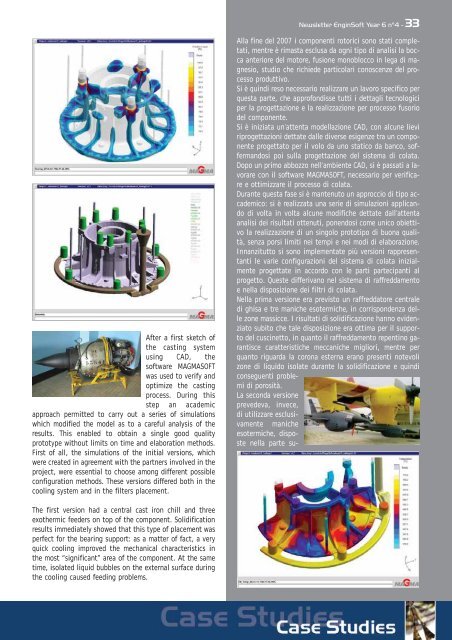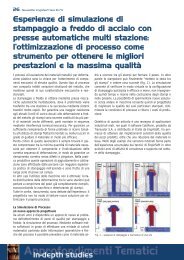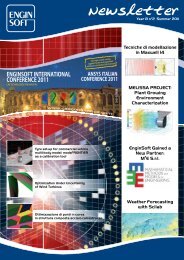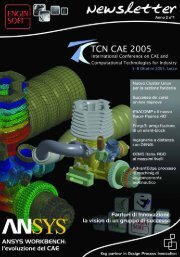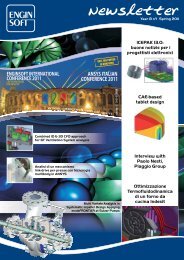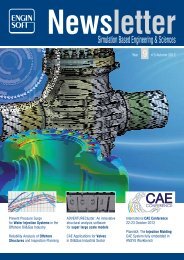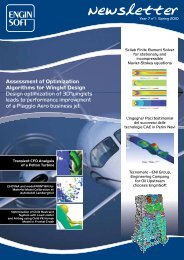software training courses 2010 corsi di addestramento ... - EnginSoft
software training courses 2010 corsi di addestramento ... - EnginSoft
software training courses 2010 corsi di addestramento ... - EnginSoft
Create successful ePaper yourself
Turn your PDF publications into a flip-book with our unique Google optimized e-Paper software.
After a first sketch of<br />
the casting system<br />
using CAD, the<br />
<strong>software</strong> MAGMASOFT<br />
was used to verify and<br />
optimize the casting<br />
process. During this<br />
step an academic<br />
approach permitted to carry out a series of simulations<br />
which mo<strong>di</strong>fied the model as to a careful analysis of the<br />
results. This enabled to obtain a single good quality<br />
prototype without limits on time and elaboration methods.<br />
First of all, the simulations of the initial versions, which<br />
were created in agreement with the partners involved in the<br />
project, were essential to choose among <strong>di</strong>fferent possible<br />
configuration methods. These versions <strong>di</strong>ffered both in the<br />
cooling system and in the filters placement.<br />
The first version had a central cast iron chill and three<br />
exothermic feeders on top of the component. Soli<strong>di</strong>fication<br />
results imme<strong>di</strong>ately showed that this type of placement was<br />
perfect for the bearing support: as a matter of fact, a very<br />
quick cooling improved the mechanical characteristics in<br />
the most “significant” area of the component. At the same<br />
time, isolated liquid bubbles on the external surface during<br />
the cooling caused fee<strong>di</strong>ng problems.<br />
Newsletter <strong>EnginSoft</strong> Year 6 n°4 - 33<br />
Alla fine del 2007 i componenti rotorici sono stati completati,<br />
mentre è rimasta esclusa da ogni tipo <strong>di</strong> analisi la bocca<br />
anteriore del motore, fusione monoblocco in lega <strong>di</strong> magnesio,<br />
stu<strong>di</strong>o che richiede particolari conoscenze del processo<br />
produttivo.<br />
Si è quin<strong>di</strong> reso necessario realizzare un lavoro specifico per<br />
questa parte, che approfon<strong>di</strong>sse tutti i dettagli tecnologici<br />
per la progettazione e la realizzazione per processo fusorio<br />
del componente.<br />
Si è iniziata un’attenta modellazione CAD, con alcune lievi<br />
riprogettazioni dettate dalle <strong>di</strong>verse esigenze tra un componente<br />
progettato per il volo da uno statico da banco, soffermandosi<br />
poi sulla progettazione del sistema <strong>di</strong> colata.<br />
Dopo un primo abbozzo nell’ambiente CAD, si è passati a lavorare<br />
con il <strong>software</strong> MAGMASOFT, necessario per verificare<br />
e ottimizzare il processo <strong>di</strong> colata.<br />
Durante questa fase si è mantenuto un approccio <strong>di</strong> tipo accademico:<br />
si è realizzata una serie <strong>di</strong> simulazioni applicando<br />
<strong>di</strong> volta in volta alcune mo<strong>di</strong>fiche dettate dall’attenta<br />
analisi dei risultati ottenuti, ponendosi come unico obiettivo<br />
la realizzazione <strong>di</strong> un singolo prototipo <strong>di</strong> buona qualità,<br />
senza porsi limiti nei tempi e nei mo<strong>di</strong> <strong>di</strong> elaborazione.<br />
Innanzitutto si sono implementate più versioni rappresentanti<br />
le varie configurazioni del sistema <strong>di</strong> colata inizialmente<br />
progettate in accordo con le parti partecipanti al<br />
progetto. Queste <strong>di</strong>fferivano nel sistema <strong>di</strong> raffreddamento<br />
e nella <strong>di</strong>sposizione dei filtri <strong>di</strong> colata.<br />
Nella prima versione era previsto un raffreddatore centrale<br />
<strong>di</strong> ghisa e tre maniche esotermiche, in corrispondenza delle<br />
zone massicce. I risultati <strong>di</strong> soli<strong>di</strong>ficazione hanno evidenziato<br />
subito che tale <strong>di</strong>sposizione era ottima per il supporto<br />
del cuscinetto, in quanto il raffreddamento repentino garantisce<br />
caratteristiche meccaniche migliori, mentre per<br />
quanto riguarda la corona esterna erano presenti notevoli<br />
zone <strong>di</strong> liquido isolate durante la soli<strong>di</strong>ficazione e quin<strong>di</strong><br />
conseguenti problemi<br />
<strong>di</strong> porosità.<br />
La seconda versione<br />
prevedeva, invece,<br />
<strong>di</strong> utilizzare esclusivamente<br />
maniche<br />
esotermiche, <strong>di</strong>sposte<br />
nella parte su-


